Impact of Joint Assimilating AWS and Radar Observations on the Analysis and Forecast of a Squall Line with Complex Terrain
Highlights
- A radar assimilation scheme with spatial truncation enhances convective structure representation and suppresses false echoes.
- Joint assimilation of AWS and radar data improves horizontal continuity and vertical consistency in convective analyses.
- Assimilating AWS before radar establishes a balanced boundary-layer environment, strengthening cold-pool intensity and updraft coupling.
- This assimilation sequence enables more accurate reproduction of convective circulation and vertical wind structures within the squall line.
Abstract
1. Introduction
2. Data and Methods
2.1. 3DVar Method in WRFDA
2.2. Radar Observations
2.2.1. DA Method
2.2.2. Spatial Truncation
2.3. Surface Observations
2.4. Choice of Variance and Length Scaling Parameters
3. Case Overview and Experiments
3.1. Case Overview
3.2. Model Configurations and Experimental Design
3.2.1. Model Configurations
3.2.2. Experimental Design
4. Results
4.1. Radar Assimilation
4.1.1. Spatial Truncation Radar Reflectivity Observations
4.1.2. Assimilation Scales of Radar Observations
4.2. Combined Assimilation of AWS and Radar Data
4.2.1. Analysis Results
4.2.2. Forecast Results
5. Discussion
6. Conclusions
Author Contributions
Funding
Data Availability Statement
Acknowledgments
Conflicts of Interest
References
- Houze, R.A. Mesoscale convective systems. Rev. Geophys. 2004, 42, RG4003. [Google Scholar] [CrossRef]
- Li, J.; Feng, Z.; Qian, Y.; Leung, L.R. A high-resolution unified observational data product of mesoscale convective systems and isolated deep convection in the United States for 2004–2017. Earth Syst. Sci. Data 2021, 13, 827–856. [Google Scholar] [CrossRef]
- Rotunno, R.; Klemp, J.B.; Weisman, M.L. A theory for strong, long-lived squall lines. J. Atmos. Sci. 1988, 45, 463–485. [Google Scholar] [CrossRef]
- Weisman, M.L.; Klemp, J.B. The dependence of numerically simulated convective storms on vertical wind shear and buoyancy. Mon. Weather Rev. 1982, 110, 504–520. [Google Scholar] [CrossRef]
- Fan, J.; Han, B.; Varble, A.; Morrison, H.; North, K.; Kollias, P.; Chen, B.; Dong, X.; Giangrande, S.E.; Khain, A.; et al. Cloud-resolving model intercomparison of an MC3E squall line case: Part I—Convective updrafts. J. Geophys. Res. Atmos. 2017, 122, 9351–9378. [Google Scholar] [CrossRef]
- Bao, J.-W.; Michelson, S.A.; Grell, E.D. Microphysical process comparison of three microphysics parameterization schemes in the WRF model for an idealized squall-line case study. Mon. Weather Rev. 2019, 147, 3093–3120. [Google Scholar] [CrossRef]
- Parrish, D.F.; Derber, J.C. The National Meteorological Center’s spectral statistical-interpolation analysis system. Mon. Weather Rev. 1992, 120, 1747–1763. [Google Scholar] [CrossRef]
- Courtier, P.; Andersson, E.; Heckley, W.; Vasiljevic, D.; Hamrud, M.; Hollingsworth, A.; Rabier, F.; Fisher, M.; Pailleux, J. The ECMWF implementation of three-dimensional variational assimilation (3DVar). Q. J. R. Meteorol. Soc. 1998, 124, 1783–1807. [Google Scholar] [CrossRef]
- Purser, R.J.; Wu, W.S.; Parrish, D.F.; Roberts, N.M. Numerical aspects of the application of recursive filters to variational statistical analysis. Part I: Spatially homogeneous and isotropic Gaussian covariances. Mon. Weather Rev. 2003, 131, 1524–1535. [Google Scholar] [CrossRef]
- Barker, D.M.; Huang, W.; Guo, Y.-R.; Bourgeois, A.J.; Xiao, Q.N. A three-dimensional variational data assimilation system for MM5: Implementation and initial results. Mon. Weather Rev. 2004, 132, 897–914. [Google Scholar] [CrossRef]
- Brousseau, P.; Berre, L.; Bouttier, F.; Desroziers, G. Background-error covariances for a convective-scale data-assimilation system: AROME-France 3DVar. Q. J. R. Meteorol. Soc. 2011, 137, 409–422. [Google Scholar] [CrossRef]
- Xu, D.; Song, T.; Li, H.; Min, J.; Luo, J.; Shen, F. Four-Dimensional Variational Assimilation of Precipitation Data with the Large-Scale Analysis Constraint in the 21.7 Extreme Rainfall Event in China. J. Geophys. Res. Atmos. 2025, 130, e2024JD042522. [Google Scholar] [CrossRef]
- Buehner, M.; Houtekamer, P.L.; Charette, C.; Mitchell, H.L.; He, B. Intercomparison of variational data assimilation and the ensemble Kalman filter for global deterministic NWP. Part I: Description and single-observation experiments. Mon. Weather Rev. 2010, 138, 1550–1566. [Google Scholar] [CrossRef]
- Gao, J.; Stensrud, D.J. Assimilation of reflectivity data in a convective-scale, cycled 3DVAR framework with hydrometeor classification. J. Atmos. Sci. 2012, 69, 1054–1065. [Google Scholar] [CrossRef]
- Sun, J.; Xue, M.; Wilson, J.W.; Zawadzki, I.; Ballard, S.P.; Onvlee-Hooimeyer, J.; Joe, P.; Barker, D.M.; Li, P.-W.; Golding, B.; et al. Use of NWP for nowcasting convective precipitation: Recent progress and challenges. Bull. Am. Meteorol. Soc. 2014, 95, 409–426. [Google Scholar] [CrossRef]
- Shen, F.; Shu, A.; Min, J.; Wu, Z.; Wang, Y.; Xu, D.; Chen, J.; Wan, S. Assimilation of dual-pol radar KDP observations with the GSI ensemble Kalman filter for the analysis and prediction of a squall line. J. Geophys. Res. Atmos. 2025, 130, e2024JD041933. [Google Scholar] [CrossRef]
- Tong, M.; Xue, M. Ensemble Kalman filter assimilation of Doppler radar data with a compressible nonhydrostatic model: OSS experiments. Mon. Weather. Rev. 2005, 133, 1789–1807. [Google Scholar] [CrossRef]
- Shen, F.; Song, L.; Li, H.; He, Z.; Xu, D. Effects of Different Momentum Control Variables in Radar Data Assimilation on the Analysis and Forecast of a Strong Convective System in the Northeast China. SSRN 2022. [Google Scholar] [CrossRef]
- Pu, Z.; Zhang, H.; Anderson, J. Ensemble Kalman filter assimilation of near-surface observations over complex terrain: Comparison with 3DVAR for short-range forecasts. Tellus A Dyn. Meteorol. Oceanogr. 2013, 65, 19620. [Google Scholar] [CrossRef]
- Benjamin, S.G.; Weygandt, S.S.; Brown, J.M.; Hu, M.; Alexander, C.R.; Smirnova, T.G.; Olson, J.B.; James, E.P.; Dowell, D.C.; Grell, G.A.; et al. A North American hourly assimilation and model forecast cycle: The Rapid Refresh. Mon. Weather Rev. 2016, 144, 1669–1694. [Google Scholar] [CrossRef]
- Hou, T.; Min, J.; Xue, M.; Luo, Y. Evaluation of radar and automatic weather station data assimilation for a heavy rainfall event in southern China. Adv. Atmos. Sci. 2015, 32, 1065–1080. [Google Scholar] [CrossRef]
- Ha, J.-H.; Lee, J.-H.; Kwon, T.-Y. Observation and numerical simulations with radar and surface data assimilation for heavy rainfall over central Korea. Adv. Atmos. Sci. 2011, 28, 573–590. [Google Scholar] [CrossRef]
- Chen, I.-H.; Wang, W.; Sun, J.; Xu, D. Improving afternoon thunderstorm prediction over Taiwan through 3DVar-based radar and surface data assimilation. Weather Forecast. 2020, 35, 2373–2391. [Google Scholar] [CrossRef]
- Skamarock, W.C.; Klemp, J.B.; Dudhia, J.; Gill, D.O.; Barker, D.; Duda, M.G.; Huang, X.-Y.; Wang, W.; Powers, J.G. A Description of the Advanced Research WRF, version 3; NCAR Technical Note NCAR/TN-475+STR; University Corporation for Atmospheric Research: Boulder, CO, USA, 2008; Available online: https://opensky.ucar.edu/islandora/object/technotes:500 (accessed on 1 November 2025).
- Barker, D.; Huang, X.Y.; Liu, Z.; Auligné, T.; Zhang, X.; Rugg, S.; Ajjaji, R.; Bourgeois, A.; Bray, J.; Chen, Y.; et al. The Weather Research and Forecasting Model’s Community Variational/Ensemble Data Assimilation System: WRFDA. Bull. Am. Meteorol. Soc. 2012, 93, 831–843. [Google Scholar] [CrossRef]
- Chen, J.; Xu, D.; Shu, A.; Song, L. The Impact of Radar Radial Velocity Data Assimilation Using WRF-3DVAR System with Different Background Error Length Scales on the Forecast of Super Typhoon Lekima (2019). Remote Sens. 2023, 15, 2592. [Google Scholar] [CrossRef]
- Wang, X.; Shen, F.; Wan, S.; Liu, J.; Fei, H.; Shao, C.; Yuan, S.; Chen, J.; Yuan, X. Enhancing Typhoon Doksuri (2023) Forecasts via Radar Data Assimilation: Evaluation of Momentum Control Variable Schemes with Background-Dependent Hydrometeor Retrieval in WRF-3DVAR. Atmosphere 2025, 16, 797. [Google Scholar] [CrossRef]
- NCAR/UCAR. Lrose-Solo3: C++ Version of SOLO Polar Radar Data Display and Editor. 2025. Available online: https://github.com/NCAR/lrose-solo3 (accessed on 1 November 2025).
- Ha, S.-Y.; Snyder, C. Influence of surface observations in mesoscale data assimilation using an ensemble Kalman filter. Mon. Weather Rev. 2014, 142, 1489–1508. [Google Scholar] [CrossRef]
- Lei, L.; Anderson, J.L. Impacts of frequent assimilation of surface pressure observations on atmospheric analyses. Mon. Weather Rev. 2014, 142, 4477–4483. [Google Scholar] [CrossRef]
- Wang, S.; Liu, Z. A radar reflectivity operator with ice-phase hydrometeors for variational data assimilation (version 1.0) and its evaluation with real radar data. Geosci. Model Dev. 2019, 12, 4031–4051. [Google Scholar] [CrossRef]
- Thompson, G.; Field, P.R.; Rasmussen, R.M.; Hall, W.D. Explicit forecasts of Winter Precipitation Using an Improved Bulk Microphysics Scheme. Part II: Implementation of a New Snow Parameterization. Mon. Weather Rev. 2008, 136, 5095–5115. [Google Scholar] [CrossRef]
- Iacono, M.J.; Delamere, J.S.; Mlawer, E.J.; Shephard, M.W.; Clough, S.A.; Collins, W.D. Radiative forcing by long-lived greenhouse gases: Calculations with the AER radiative transfer models. J. Geophys. Res. Atmos. 2008, 113, D13103. [Google Scholar] [CrossRef]
- Mukul Tewari, N.C.; Tewari, M.; Chen, F.; Wang, W.; Dudhia, J.; LeMone, M.; Mitchell, K.; Ek, M.; Gayno, G.; Wegiel, J. Implementation and verification of the unified NOAH land surface model in the WRF model (Formerly Paper Number 17.5). In Proceedings of the 20th Conference on Weather Analysis and Forecasting/16th Conference on Numerical Weather Prediction, Seattle, WA, USA, 12–16 January 2004. [Google Scholar]
- Janjic, Z.I. The Step-Mountain Eta Coordinate Model: Further developments of the convection, viscous sublayer, and turbulence closure schemes. Mon. Weather Rev. 1994, 122, 927–945. [Google Scholar] [CrossRef]
- Mesinger, F. Forecast upper tropospheric turbulence within the framework of the Mellor-Yamada 2.5 closure. In Research Activities in Atmospheric and Oceanic Modeling; CAS/JSC WGNE Report No. 18; WMO: Geneva, Switzerland, 1993; pp. 4.28–4.29. Available online: https://cir.nii.ac.jp/crid/1571980075271328640 (accessed on 20 November 2025).
- Li, Z.H.; Luo, Y.L. Modeling and analysis of the dynamical and microphysical structures of two cellular rainstorms in South China coasts. Torrential Rain Disasters 2025, 44, 576–591. (In Chinese) [Google Scholar] [CrossRef]
- Wang, H.T.; Liu, X.X.; Wang, Q.C.; Li, N.; Zhou, T.; Liu, Q.; Zhang, X.; Xu, M. Analysis of environmental conditions and trigger mechanism of an elevated thunderstorm in early spring in North China. Torrential Rain Disasters 2025, 44, 361–370. (In Chinese) [Google Scholar] [CrossRef]
- Wilks, D.S. Statistical Methods in the Atmospheric Sciences, 3rd ed.; Academic Press: Cambridge, MA, USA, 2011; p. 704. [Google Scholar]
- Roberts, N.M.; Lean, H.W. Scale-selective verification of rainfall accumulations from high-resolution forecasts of convective events. Mon. Weather Rev. 2008, 136, 78–97. [Google Scholar] [CrossRef]
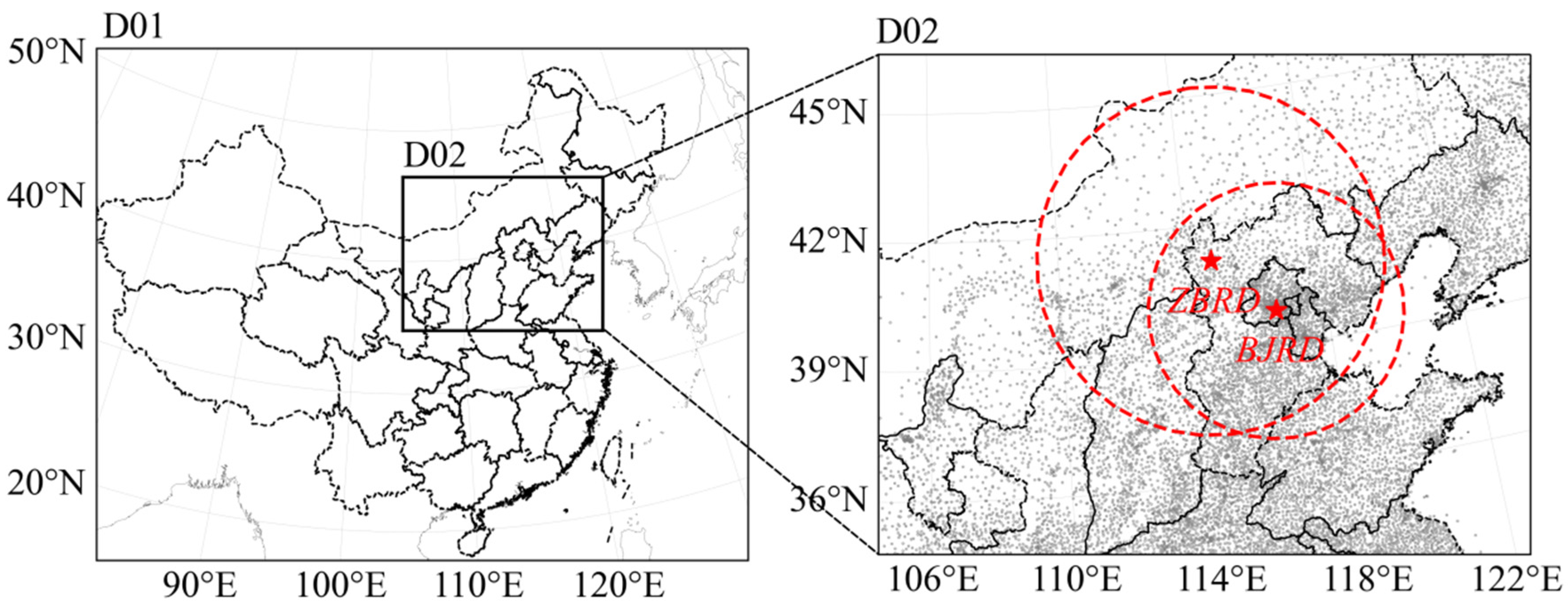
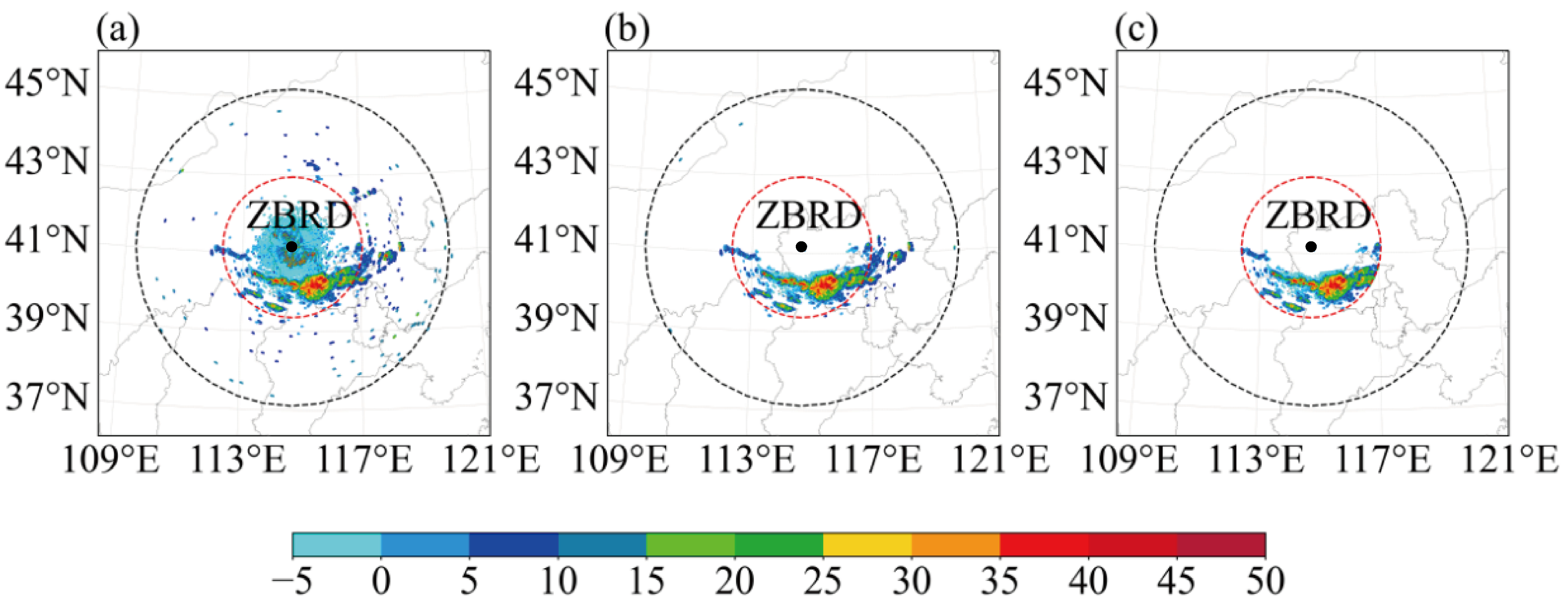


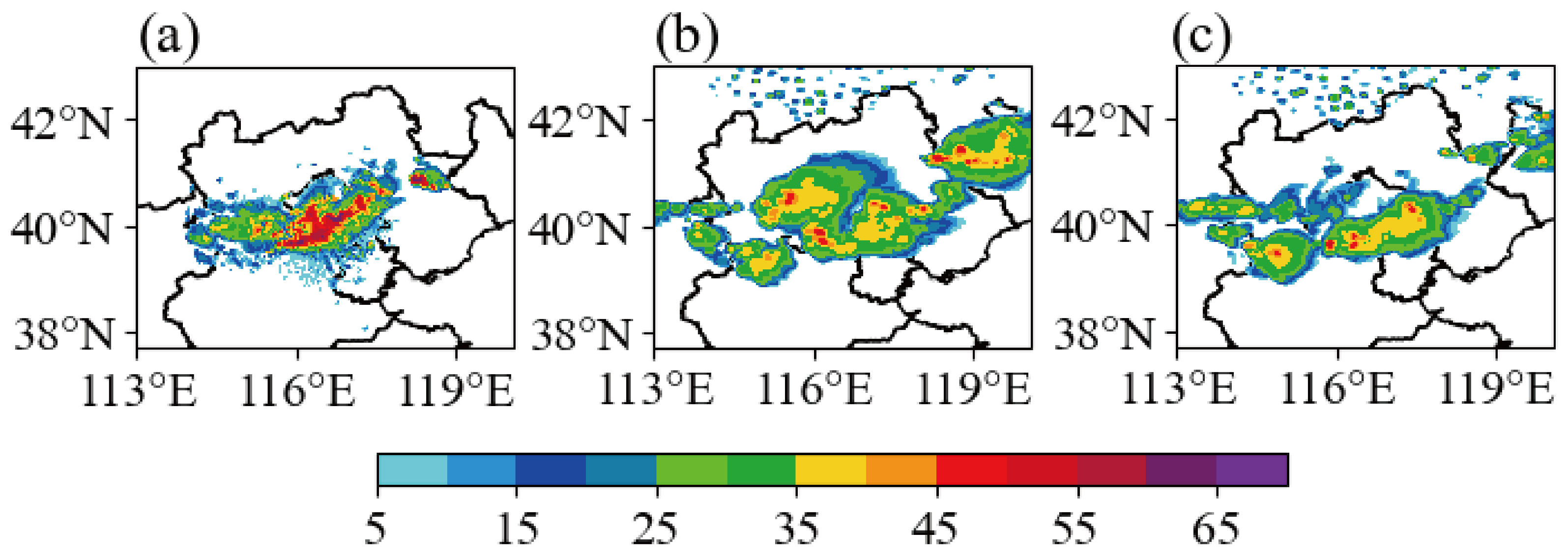
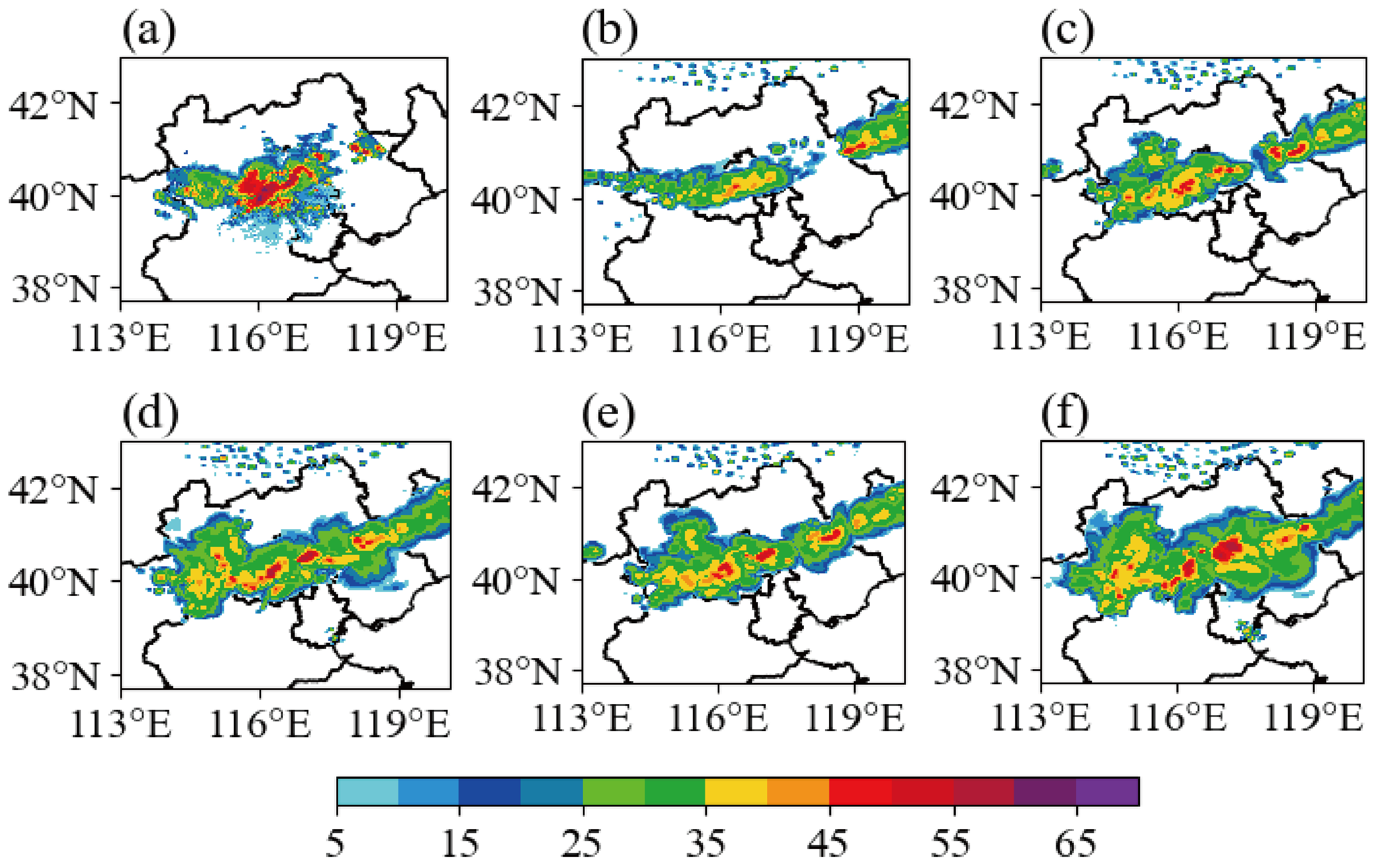

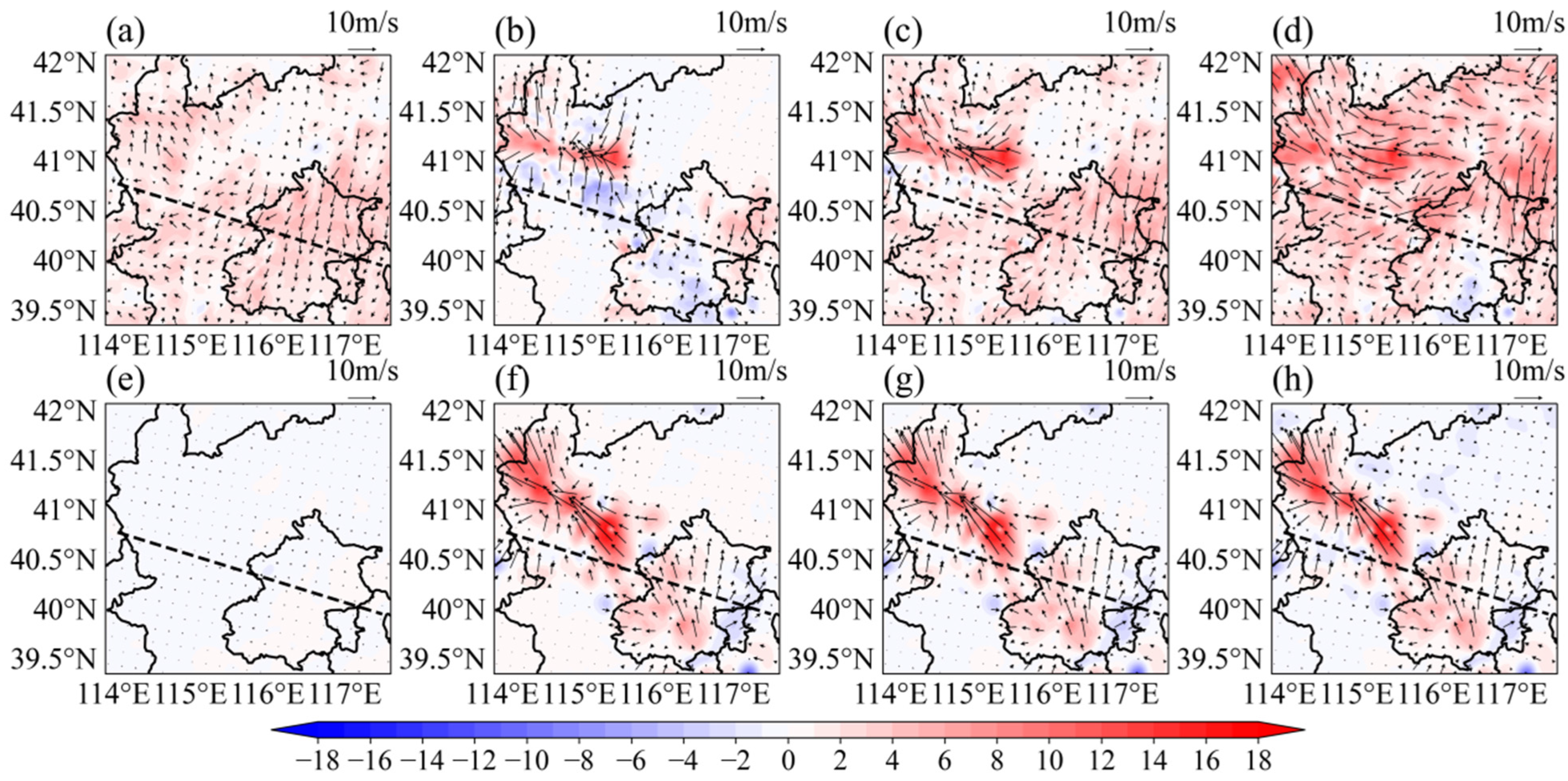
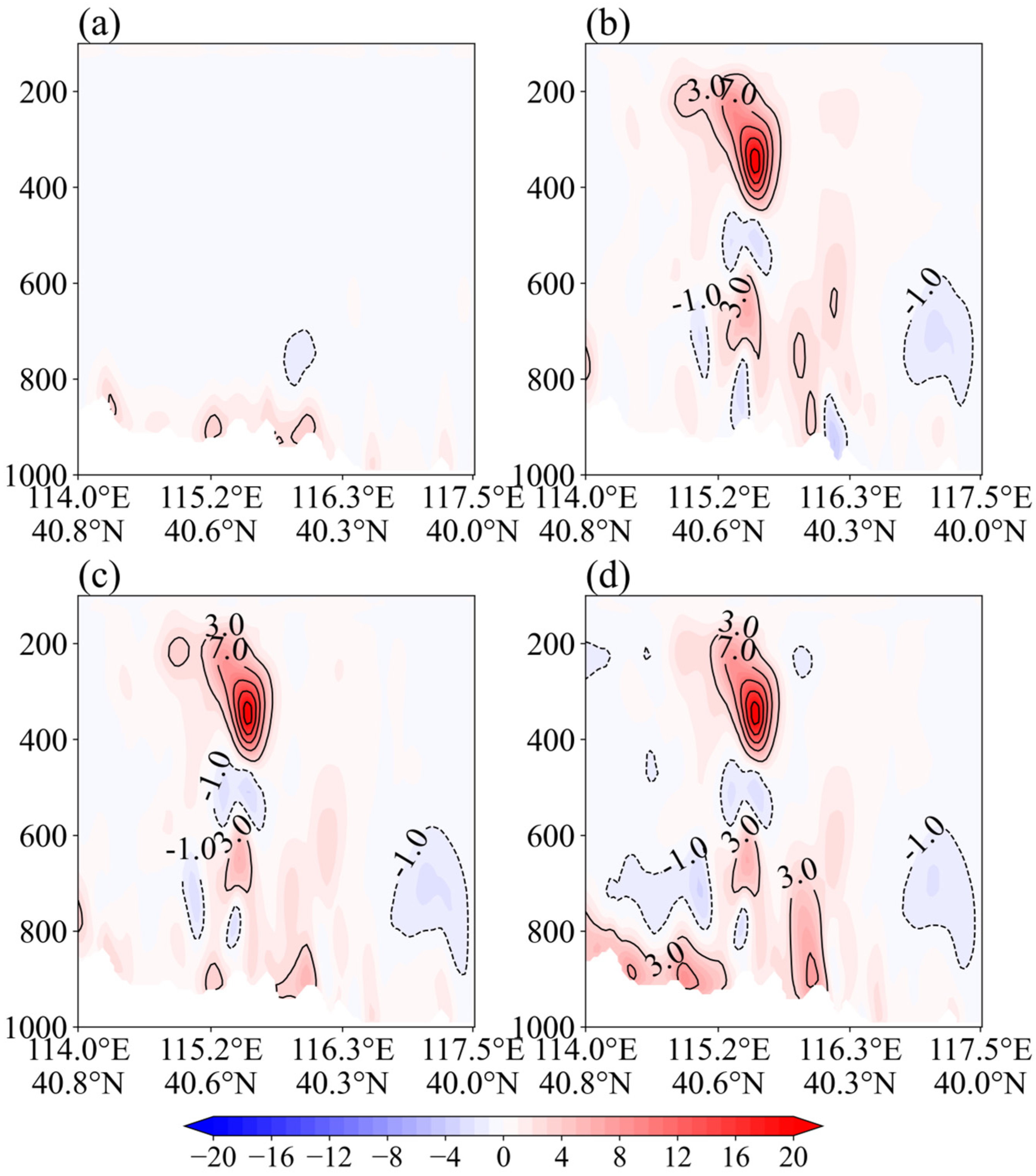

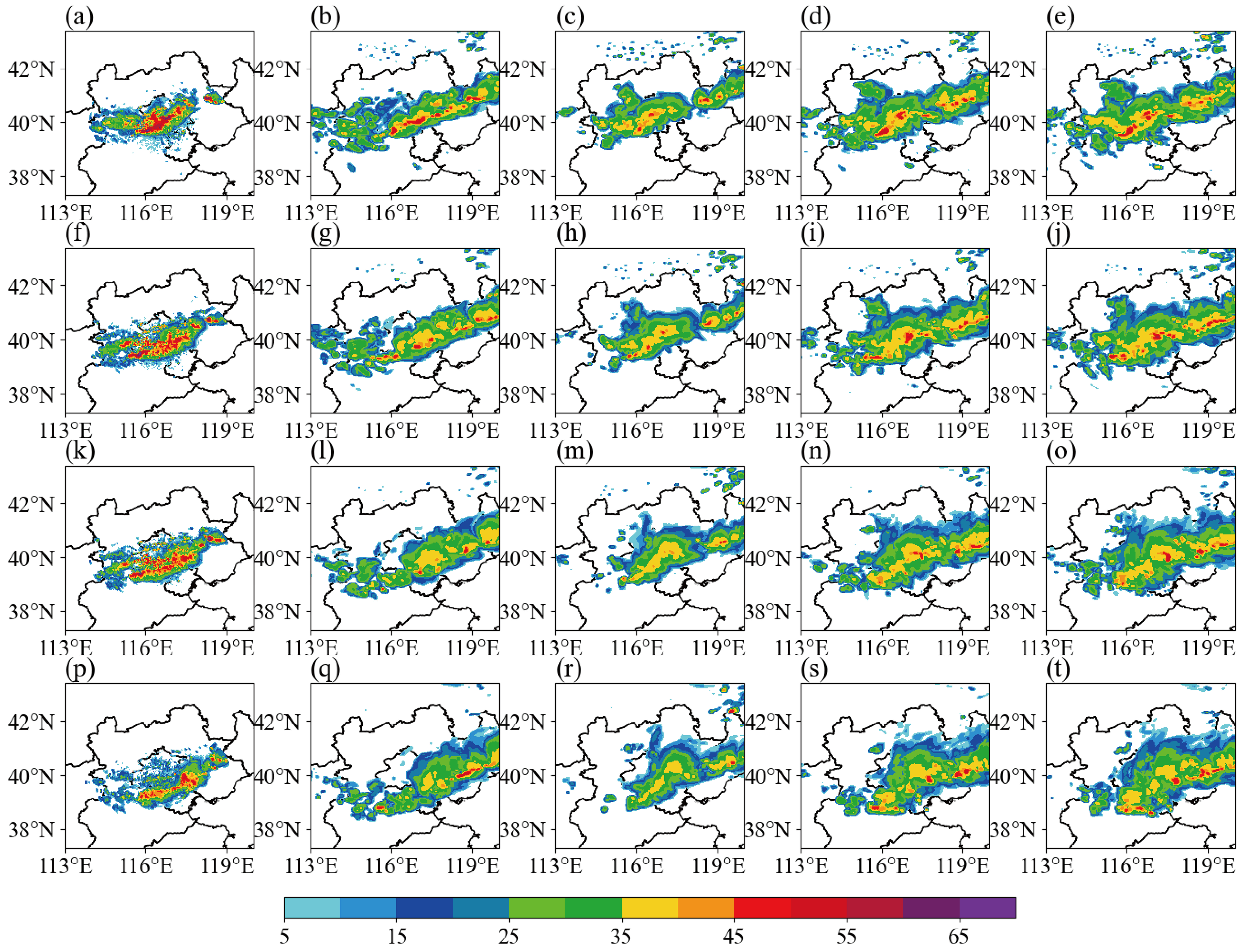
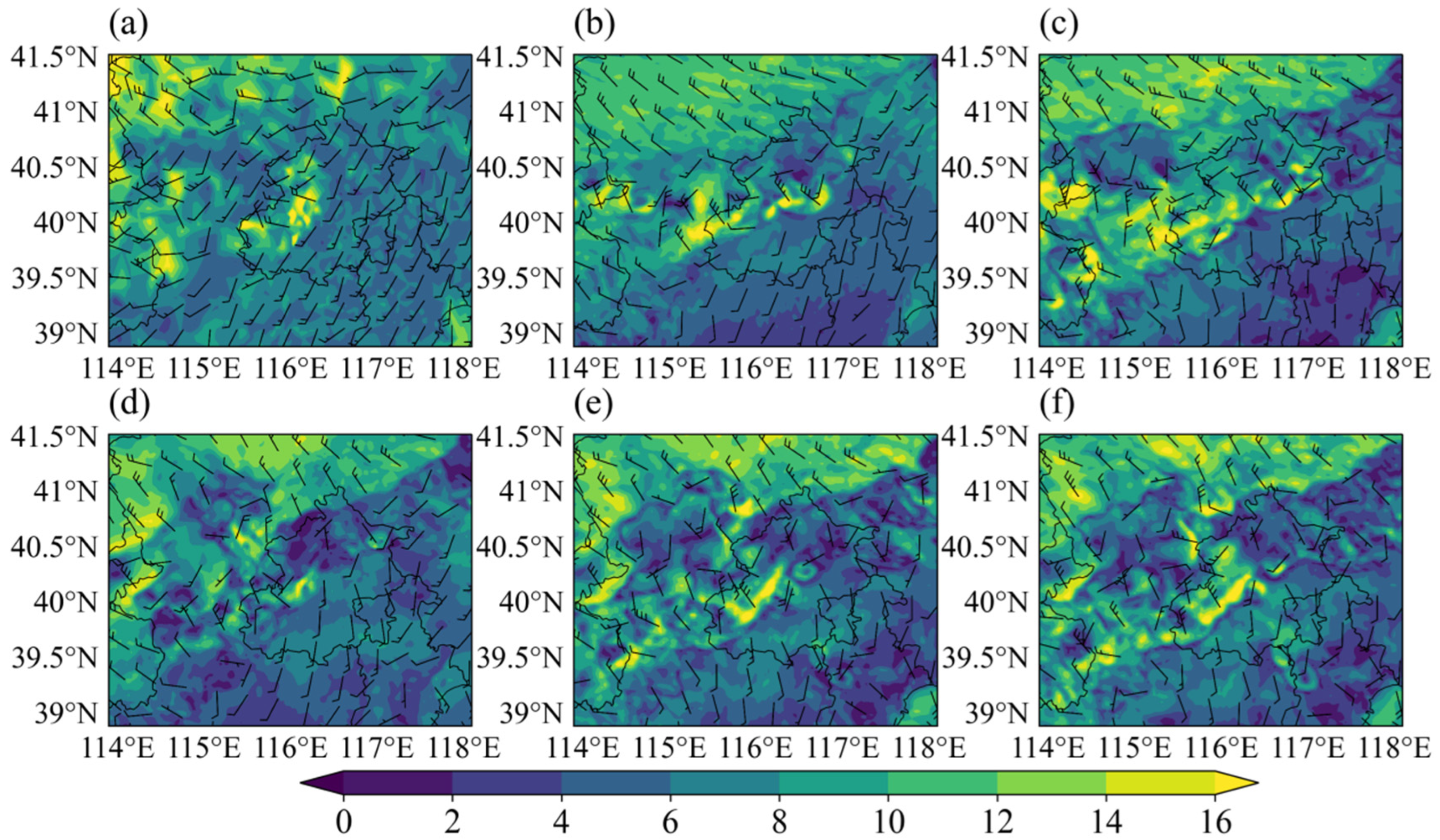
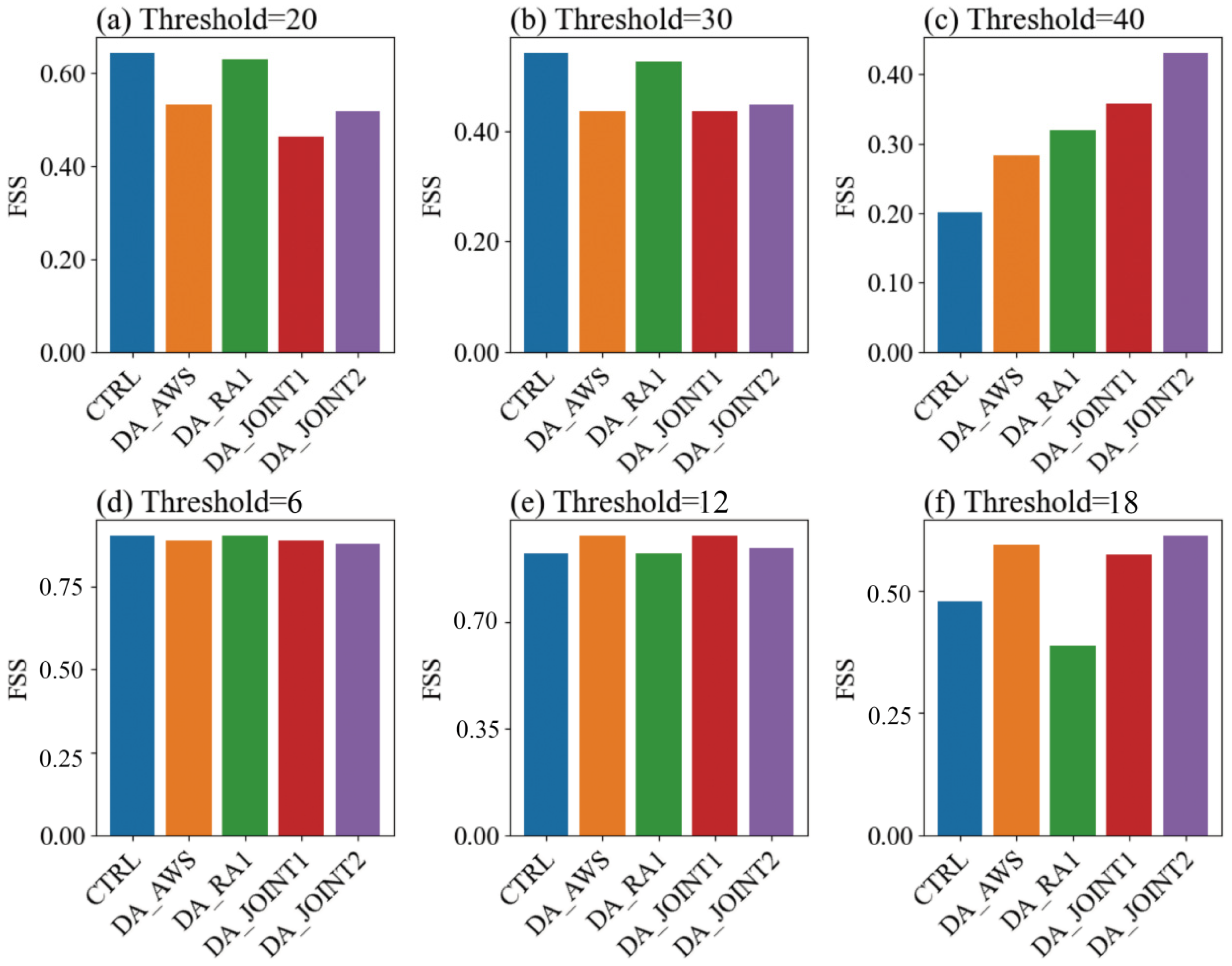
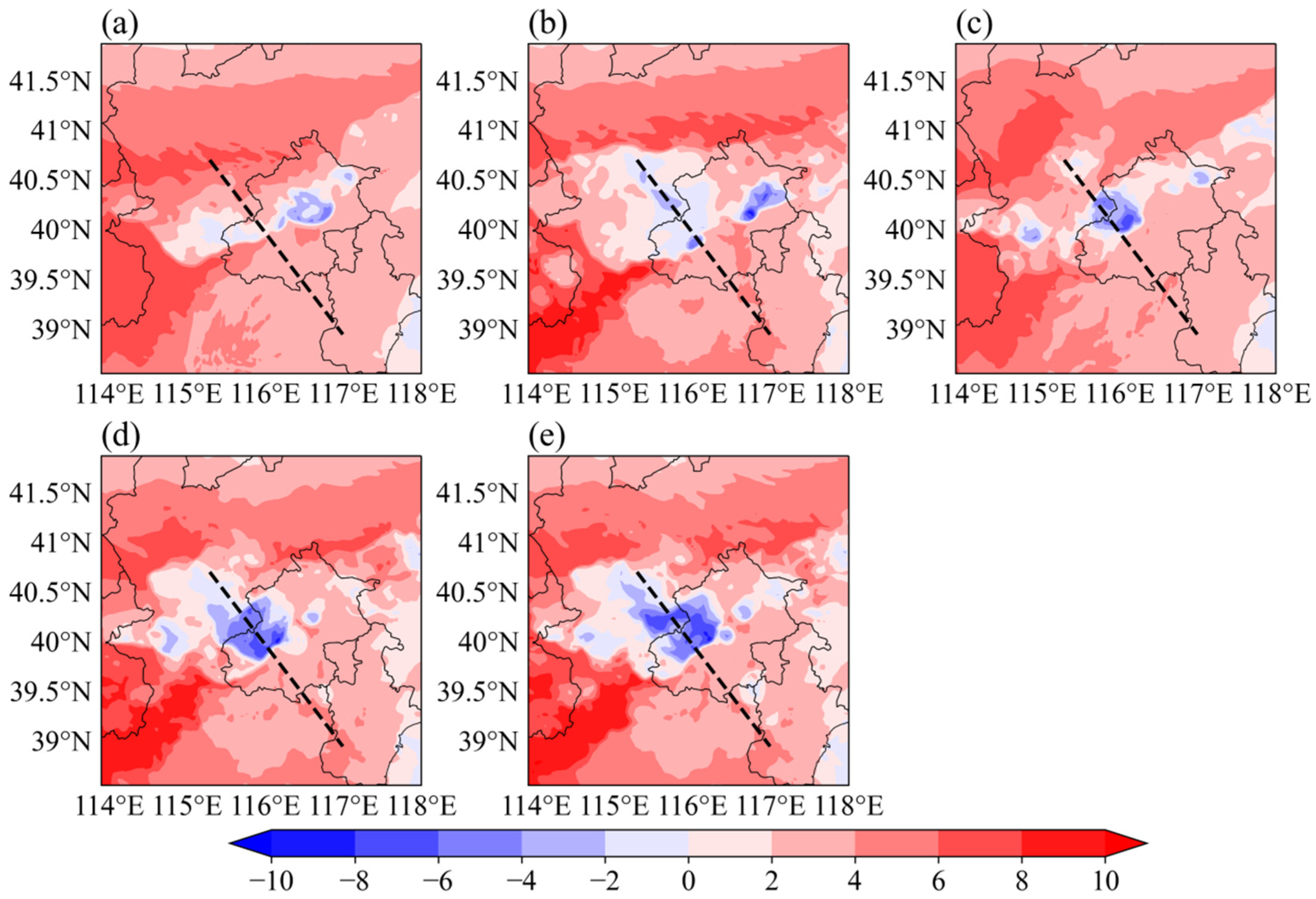
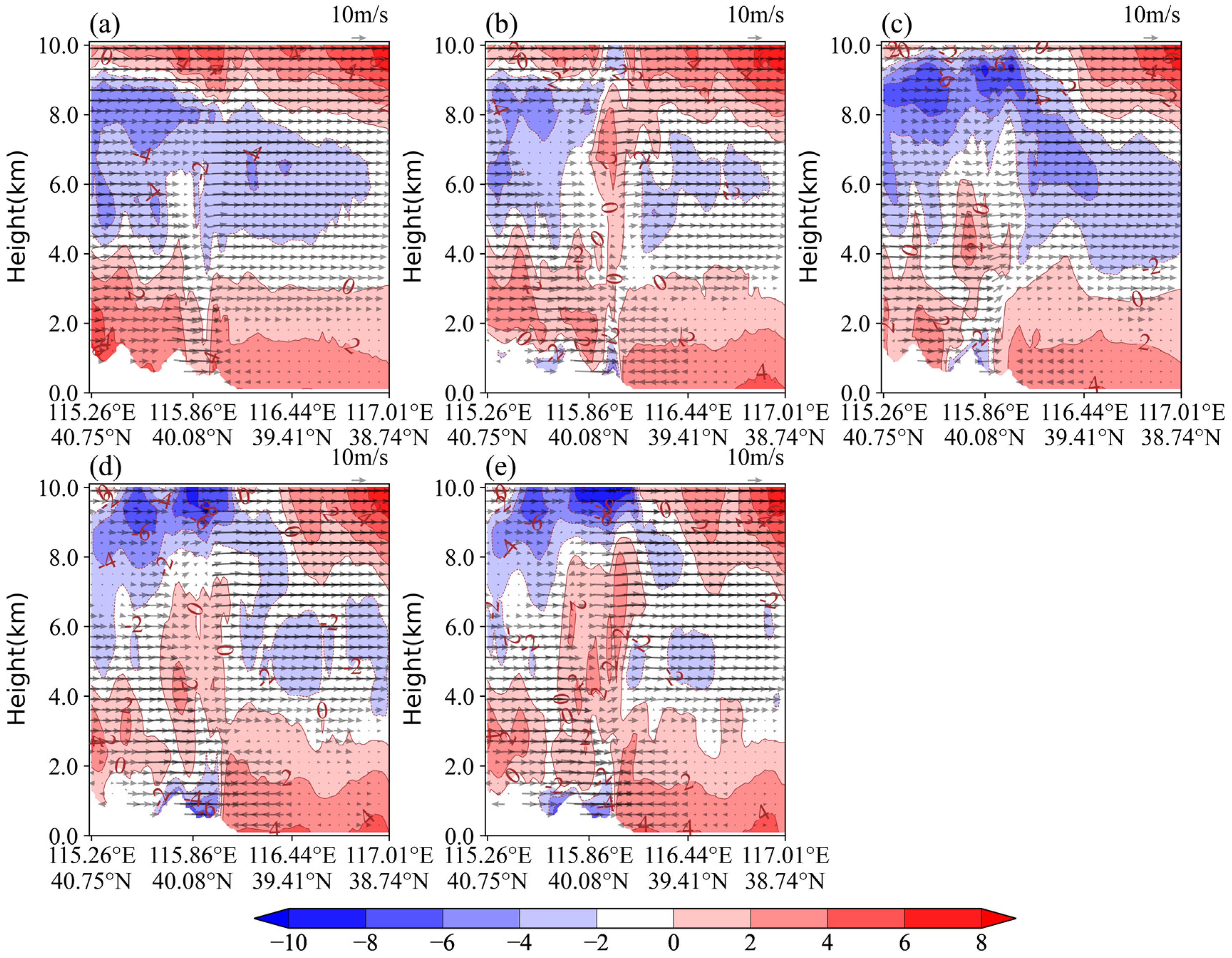
| Number | Experiment | Observations |
|---|---|---|
| 1 | CTRL | No. |
| 2 | DA_RA4_woTrc | Radar observation without spatial truncation. |
| 3 | DA_RA1 | Radar observation with spatial truncation. |
| 4 | DA_RA2 | |
| 5 | DA_RA3 | |
| 6 | DA_RA4 | |
| 7 | DA_AWS | AWS observation. |
| 8 | DA_JOINT1 | Both AWS observation and radar observation with spatial truncation. |
| 9 | DA_JOINT2 |
Disclaimer/Publisher’s Note: The statements, opinions and data contained in all publications are solely those of the individual author(s) and contributor(s) and not of MDPI and/or the editor(s). MDPI and/or the editor(s) disclaim responsibility for any injury to people or property resulting from any ideas, methods, instructions or products referred to in the content. |
© 2025 by the authors. Licensee MDPI, Basel, Switzerland. This article is an open access article distributed under the terms and conditions of the Creative Commons Attribution (CC BY) license (https://creativecommons.org/licenses/by/4.0/).
Share and Cite
Zhao, R.; Xu, D.; Li, C.; He, Z. Impact of Joint Assimilating AWS and Radar Observations on the Analysis and Forecast of a Squall Line with Complex Terrain. Remote Sens. 2025, 17, 3860. https://doi.org/10.3390/rs17233860
Zhao R, Xu D, Li C, He Z. Impact of Joint Assimilating AWS and Radar Observations on the Analysis and Forecast of a Squall Line with Complex Terrain. Remote Sensing. 2025; 17(23):3860. https://doi.org/10.3390/rs17233860
Chicago/Turabian StyleZhao, Ruonan, Dongmei Xu, Cong Li, and Zhixin He. 2025. "Impact of Joint Assimilating AWS and Radar Observations on the Analysis and Forecast of a Squall Line with Complex Terrain" Remote Sensing 17, no. 23: 3860. https://doi.org/10.3390/rs17233860
APA StyleZhao, R., Xu, D., Li, C., & He, Z. (2025). Impact of Joint Assimilating AWS and Radar Observations on the Analysis and Forecast of a Squall Line with Complex Terrain. Remote Sensing, 17(23), 3860. https://doi.org/10.3390/rs17233860







